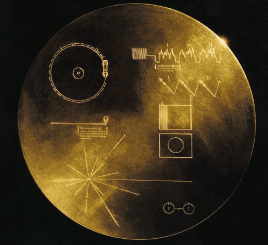From VOA Learning English, this is the Technology Report.
Space scientists recently announced that Voyager 1 is the first spacecraft to reach interstellar space - the space between stars. The spacecraft carries the voices and sounds of human beings and animals that were living on Earth in 1977 and was launched. The sounds are on a gold-plated phonograph record secured to the side of the spacecraft.
Tim Ferris mixed the audio that went on the record.
"The record is a conventional long-playing phonograph record except that it is made of copper and it is covered in gold and then it is put inside a titanium case to protect it."
Tim Ferris was one of a small group of people who worked to persuade the American space agency to attach the record to Voyager's side.
Annie Druyan, another member of the group says the original idea came from Frank Drake, an astronomer at the University of California.

NASA’s Golden Record on Voyager 1 and 2
"And it seemed to Frank that the best way to compress as much information as possible in a very small space was to do it on a phonograph record."
And there's plenty of information on the record, it contains messages in 59 human languages.
[Sounds]
It has 118 pictures of life on earth, and 27 pieces of music. Tim Ferris says these demonstrate the diversity of human creation.
"So there is music on the record from Europe and the United States... But also from Africa, the South Pacific and South America... Georgia, Russia, all these places - such as China, India."
Shortly after American astronauts returned from space in 1968, the space agency released a photograph of the Earth rising from behind the Moon.
Margaret Weitekamp is with the Smithsonian Institution's National Air and Space Museum. He says that picture deeply touched people like Frank Drake and his partner on the gold record project, the scientist and TV star Carl Sagan.
The photo made them think carefully about how they might present all humanity...not just the nation that sent the spacecraft up.
"Knowing that that picture was taken by a human being I think profoundly changed the thoughts of these people and really made them start thinking about 'If we are this pale blue dot in this ocean of vastness, then how do we communicate something about who we are?'"
As for the message they chose, Tim Ferris says they could not have chosen anything better.
"You can't say that an Indian raga or a piece by Bach or a Japanese Shakuhachi piece 'means' something that you can put into words. It is its own end product. It means really what it is. Similar to things in nature. A flower isn't a way of expressing something else. It is the end product. It is what it is."
[Sounds]
And that's the Technology Report from VOA Learning English.
译文属可可原创,仅供学习交流使用,未经许可请勿转载












